Terraforming Mars is a strategy board game that incorporates resource management, drafting, and tile placement. It’s set in the 2400s with the players taking the role of tenacious corporations who are each looking to spend entire generations of settlers to be the first to make Mars habitable. Each corporation competes for getting the most victory points, which can be earned not only by contributing to the Mars terraforming process but also for doing commendable things in the game.
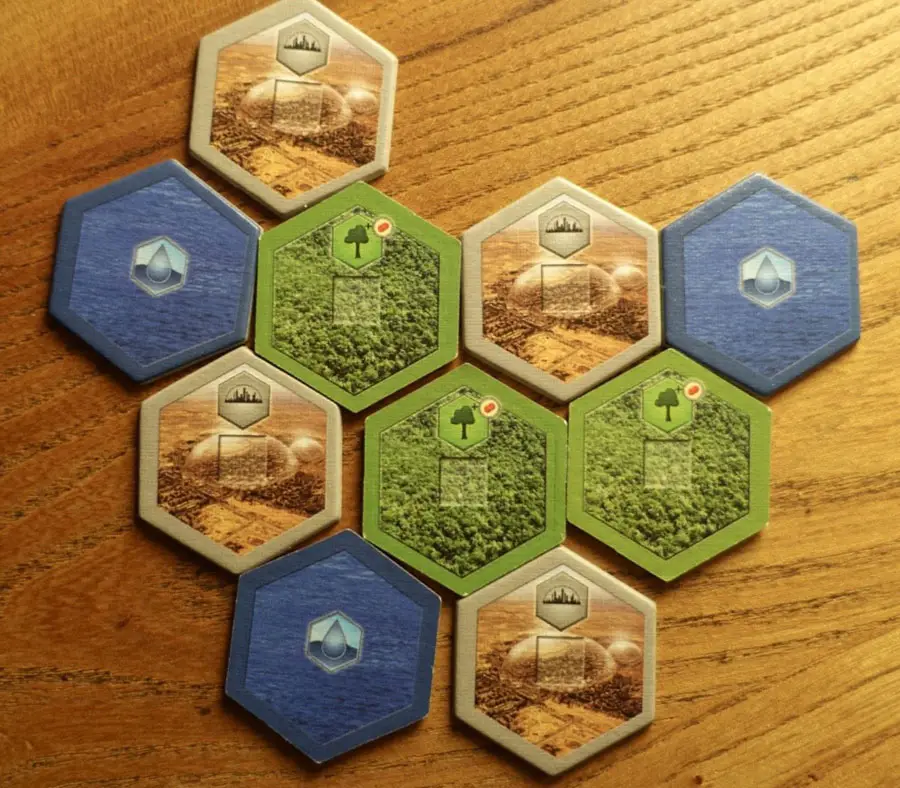
This How-to-Play guide will help you navigate through the complex and sometimes confusing structure of the Terraforming Mars mechanics.
Spelonderdelen
The Terraforming Mars box contains more than 230 playing cards, 5 player boards, an accurate map of the planet Mars, over 400 multi-colored markers (200 transparent markers, 200 resource markers, plus 3 game board markers), and 80 tiles to place on the board to mark oceans, greeneries, cities, and special tiles.

It also includes a detailed rule book that indicates the uses and functions of each game piece.
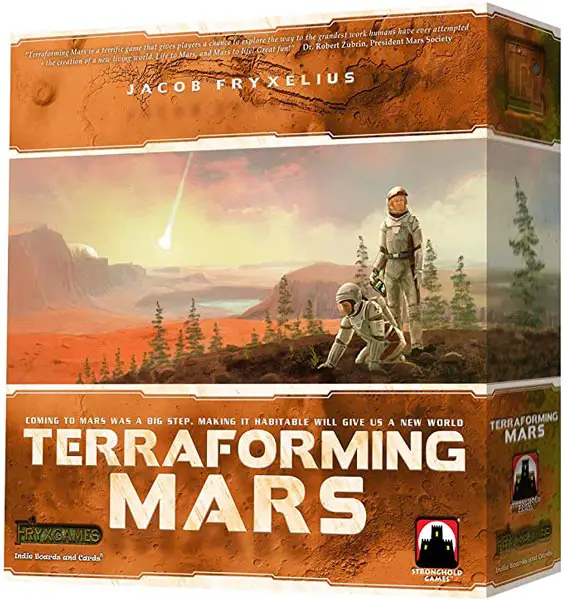
- Compete for different milestones and awards worth many VPS
- Meer dan 200 verschillende projecten om te voltooien
The Setup and The Basics of Terraforming Mars Rules
Stap 1
To start the game, place the game board in the middle of the table and set all 9 ocean tiles on the hexagonal space on the top-right part of the board.
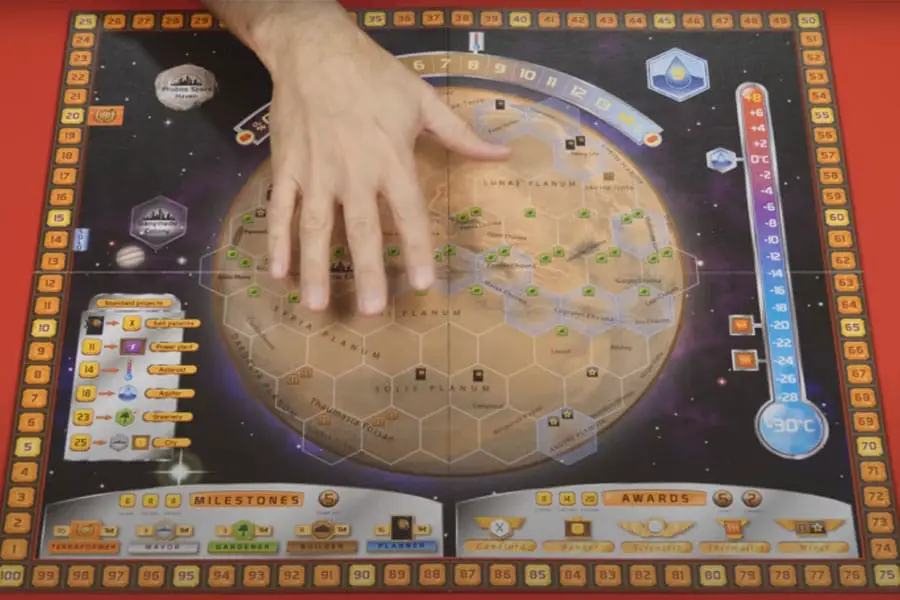
Stap 2
On the edge of the board is a track that represents your Terraform Rating (TR) levels; place 1 white marker on the “1” space.
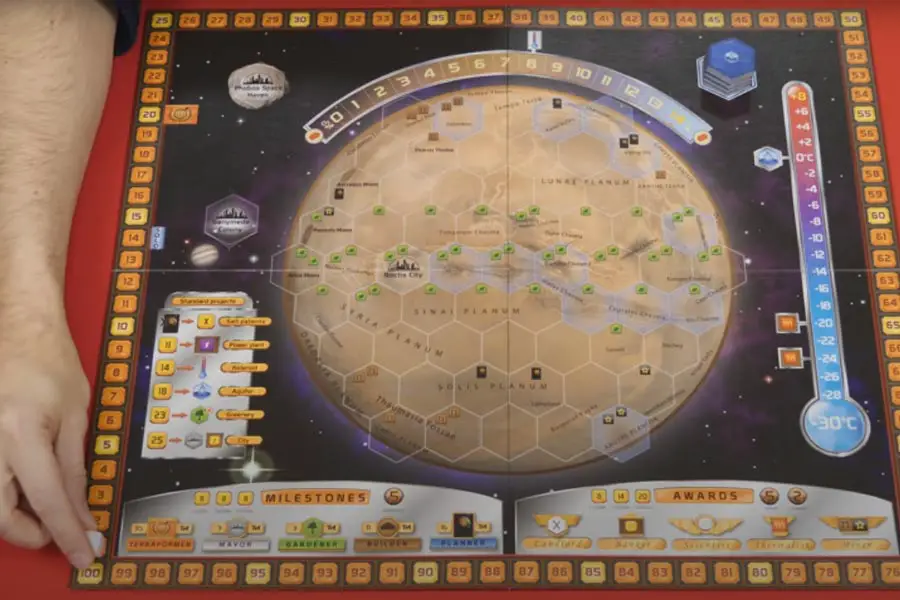
Stap 3
The oxygen levels are measured using the oxygen scale which is the arched figure on top of the board; place 1 white marker on the “0%” space.

Stap 4
Finally, the temperature is measured using the thermometer located on the right-hand corner of the board; place 1 white marker on the “30°C” space.

Stap 5
Now, have each player collect one game board and cubes in one of the 5 player colors. On your player board, you’ll find the symbols for the six types of resources available in the game: Megacredits, Steel, Titanium, Plants, Energy, and Heat.
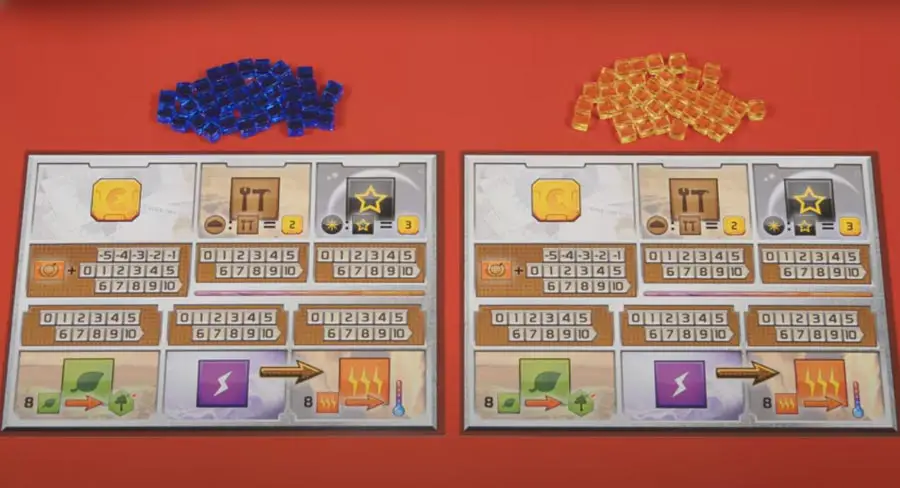
Stap 6
On your player board, you’ll also find a track that helps you monitor your corporation’s production. Place 1 colored marker on the “1” space of each track.

Put another colored marker on the “20” space of the TR track.
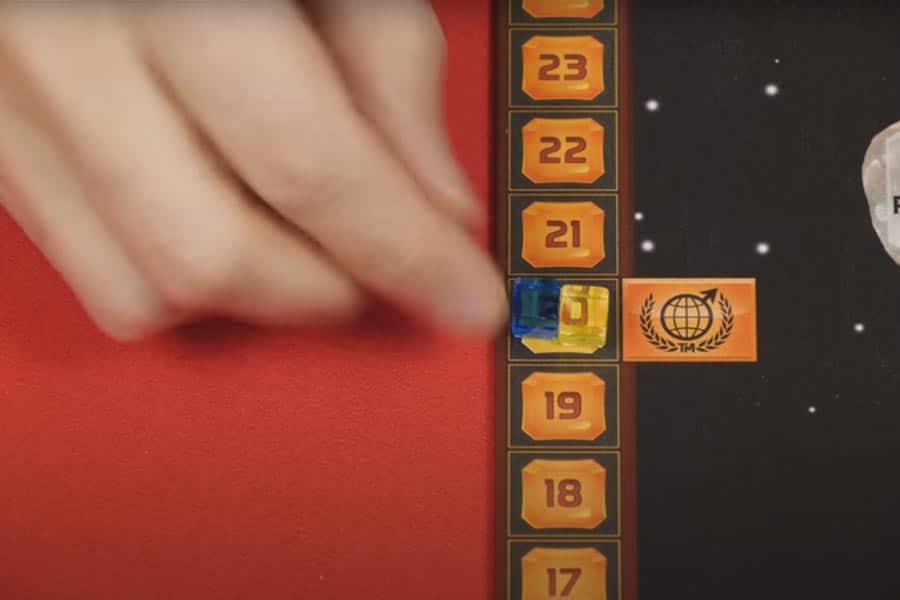
Stap 7
In this step, each player is dealt two random corporation cards to choose from. These cards indicate their base resources at the beginning of the game. Any time you gain a certain amount of any resource from cards or achievements, you take a corresponding number of cubes from the supply and place them on your player board.
- Bronze Cubes – worth 1 each
- Silver Cubes – worth 5 each
- Gold Cubes – worth 10 each
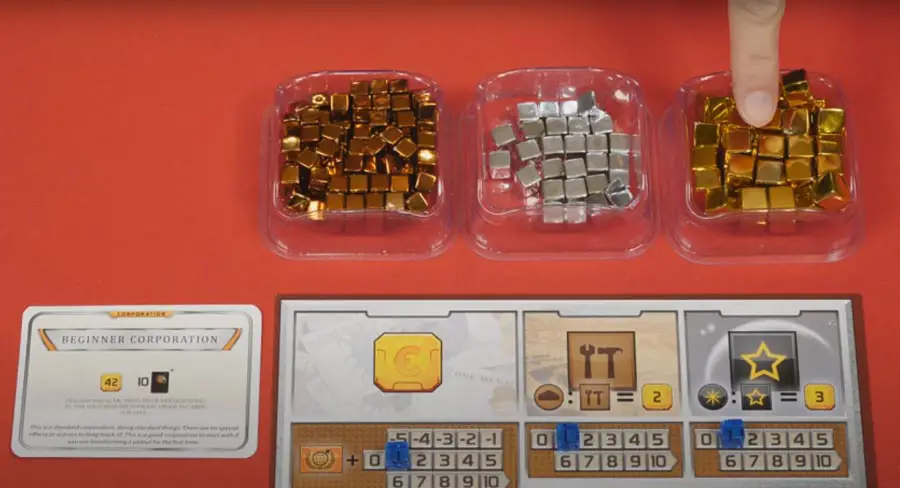
Stap 8
On top of these corporation cards, players also acquire 10 unique project cards which each represent different functions such as introducing plant life or animal life, hurling asteroids at Mars’ surface to increase the temperature, as well as building cities. These cards can also reward the player with immediate bonuses that help increase their chances of winning the game.
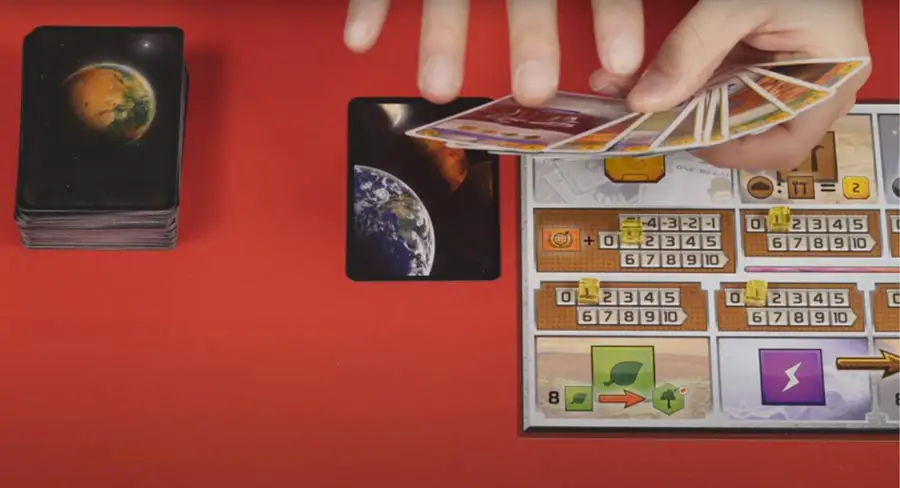
Players have the choice of buying all 10 cards or only keep a select few in their hands. Each card costs 3 Megacredits, so if you want to keep all 10, you’ll need to pay 30 for the Supply.
Stap 9
Any cards that aren’t chosen are placed facedown on the table to start a discard pile.
It’s important to note that buying cards can become quite pricy at some point in the game. When this happens, you can always utilize Standard Projects to take yourself further in the game.
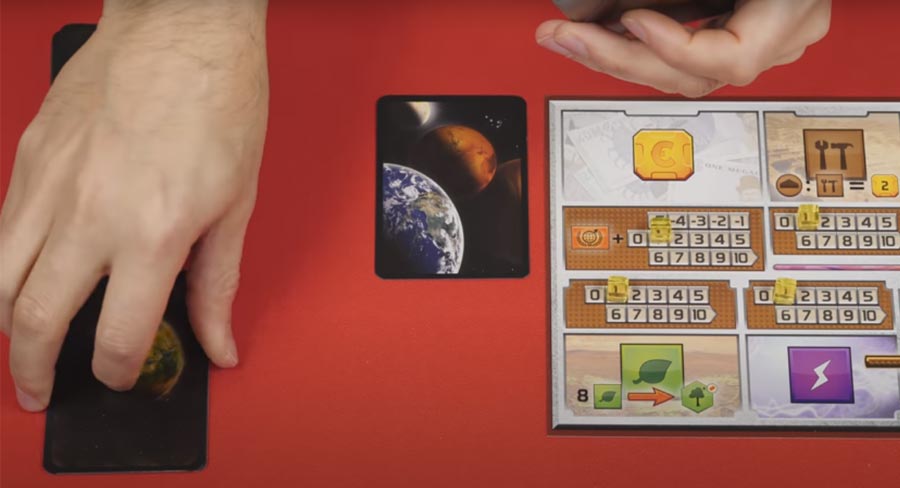
The Three Global Parameters
Each player in Terraforming Mars engages in a variety of events that help improve 3 Global Parameters: Temperature, Ocean levels, and Oxygen levels.
Raising temperature levels by one step doesn’t gain you any points. You just move the white marker up one space. However, when you reach certain points on the scale, you earn corresponding rewards for your corporation. For instance, when you reach -24°C and -20°C it lets you raise your heat production, and at 0°C it lets you place an ocean tile.
Ocean tiles can only be placed on designated ocean spaces — these are indicated by the hexagons with the blue outlines on the game board. You get 2 main credits for each adjacent tile you place.
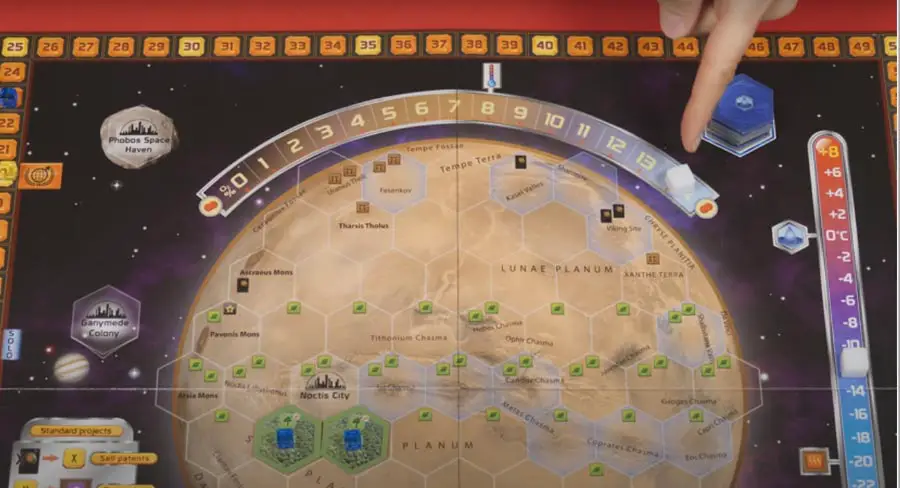
Lastly, we have oxygen.
Some cards can help increase the oxygen levels directly, but most of the time you’ll raise this parameter by placing greenery tiles on the board. When placing one of these greenery tiles, if possible, it must be next to a tile that you own.
If you don’t yet own any of the tiles on the board or don’t have enough space next to the ones that you own, you can place your greenery tile on any free space, except for those meant for ocean tiles and special locations which are reserved for cities.
After placing a greenery tile, raise the oxygen level one step, which at some point, will also raise the temperature later on.
Whenever you advance in any of these parameters, you’ll also be able to advance your TR by one, which then equal points and help you earn more money in late game.
Once all three of these parameters are set in place, this triggers the end game, and players are given a final opportunity to make Mars a little greener before final points are tallied.
Gameplay and Generations
Mars in terravorm. takes place over the course of several “generations” represented by game rounds. Each round is broken into four phases: player order phase, research phase, action phase, and production phase. (You’ll find these phases in the included Player’s Guide.)
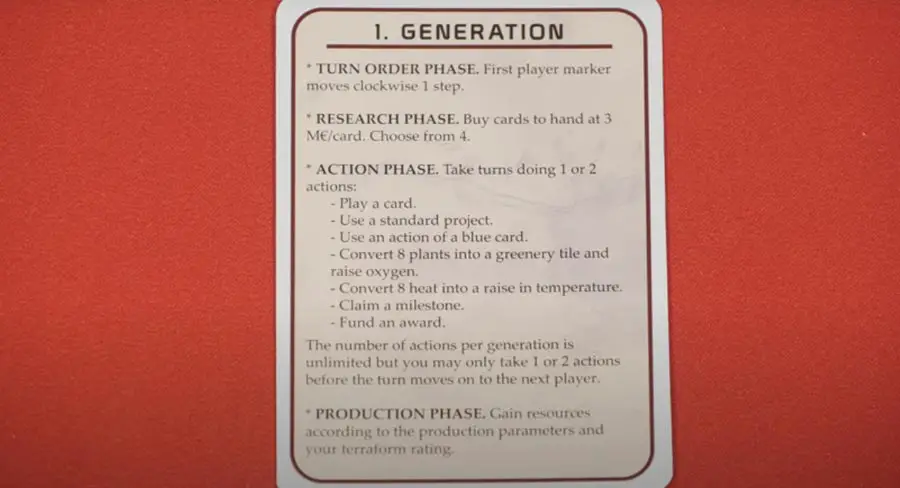
Actie fase
During the action phase, each player gets a chance to play one or two actions, starting from the player with the first player token. If you play two actions during a turn, both actions can be the same or different. Once the first player is done performing an action, the game continues in clockwise order until everyone has played their turn. If you can’t or don’t want to perform an action, you can skip the turn and pass it to the next player.
There are 7 possible actions you can choose from and you will find these on your Reference Card. These are:
- Play a card.
- Use a standard project.
- Use an action from a blue card.
- Convert 8 plants into greenery tile and raise oxygen.
- Convert 8 heat to raise the temperature.
- Claim a milestone.
- Fund a reward.
Playing a Card
The first type of action you can take is playing a card from your hand. Every card in the game is totally unique and each has a variety of symbols on them that represent different actions, bonuses, or consequences for your corporation.
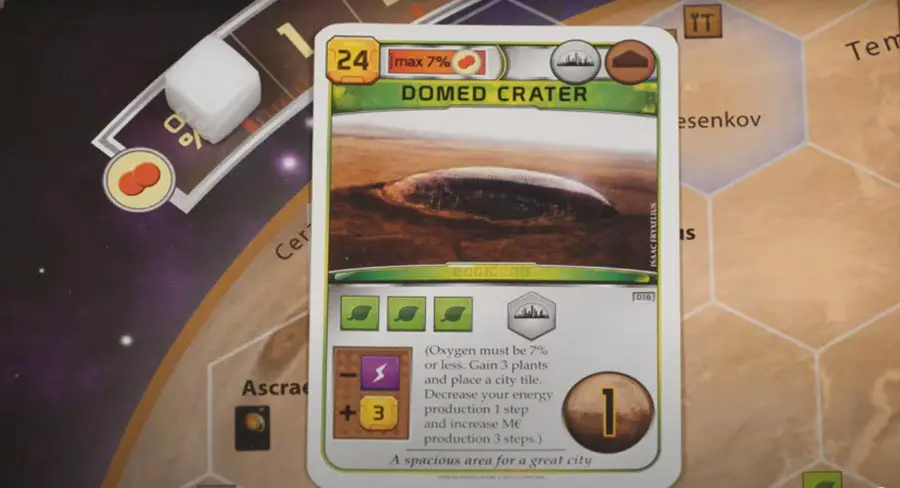
If you aren’t sure what these symbols represent, you can always read the details listed on the card or refer to the back of your Rule’s Book to see a detailed description.
Project cards represent actions that your corporation can carry out and there are 3 types: Event (red), Automated Projects (green), and Active Projects (blue).
Playing a card is simple — there’s a cost of mega credit found on the top left side of the card, and a few other prerequisites beyond that, such as a minimum or maximum amount of some other global parameter or resource.
Sometimes, a production cost is highlighted by a red border, which means you can ask any player to pay for the costs in your stead. Alternatively, if the resource has a brown borer, it increases your production by the number indicated on the card.
Cards can only be activated once per round, so when in play, place a colored marker on the card.
Using a Standard Project
There are 6 different types of standard projects which are all listed on the side of the board. These are:
- Sell Patents: This allows you to discard any card from your hand, gaining one Megacredit for each.
- Power Plant: This increases your energy production by “1” step when you pay 11 Megacredits.
- Asteroid: This allows you to increase the temperature level by “1” step after paying 14 Megacredits.
- Aquifer: This lets you place an ocean tile anywhere on the board after paying 18 Megacredits.
- Greenery: This allows you to place a greenery tile on the board after paying 23 Megacredits.
- City: This allows you to increase your Megacredit production by “1” step and lets you place a city tile on the board after paying 25 Megacredits.
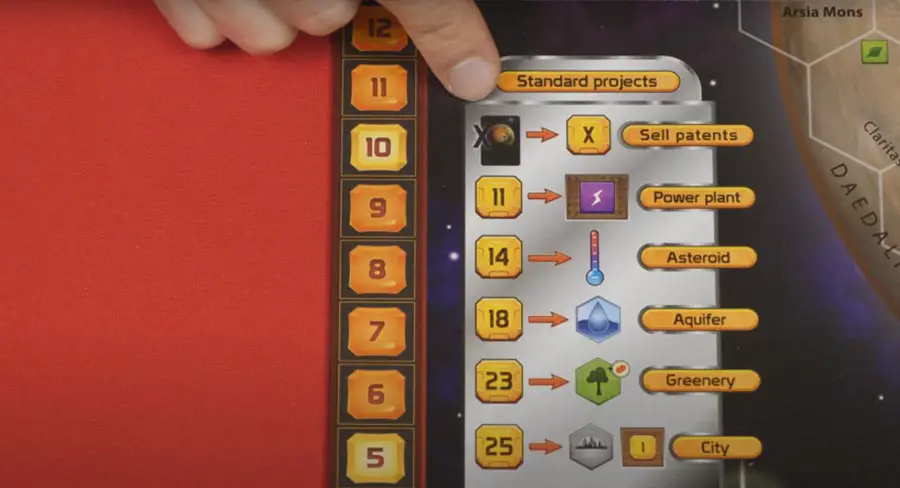
Blue Actions
Another step you can take on your turn is playing blue cards actions.
Playing Blue Action Cards is essentially the same as playing normal cards — you must pay its costs, meet its requirements, and be able to carry out any immediate effects listed on the bottom corner of the card. Blue Actions can only be used once per generation.

Some Blue Actions won’t have a cost, however, it may indicate the need for other factors such as animals, forests, etc. If such is the case, place one supply cube on the card to make up for the requirement. These will later add up to victory points to win the game.
Trade in Plants to Raise Greenery
The fourth action you can take is trading in 8 plants for a Greenery Tile. Greenery tiles increase the Oxygen level, which in turn raises your TR by “1.”
As mentioned before, Greenery tiles are best placed beside a tile that you already own, however, if you don’t have that yet, you may place it on any other vacant spaces on the board and earn corresponding bonuses and points after.

Trade in Heat to Raise Temperature
Similar to the previous action, you can also trade in 8 heat to raise the temperature by “1” step and gain “1” TR, to raise your odds of winning.

Claim a Milestone
Claiming a milestone is another type of action you can play, and you can find the types of milestones at the bottom left corner of the board.
Milestones are like achievements. When you accomplish one of them, you can claim the milestone as an action by paying 8 Megacredits and placing cubes on the milestone you’ve achieved plus the cost. At the end of the game, you’ll gain 5 points for each milestone you’ve claimed.
There are 5 types of milestones:
- Terraformer: Requires you to have at least 35 TR.
- Mayor: Requires you to have at least 3 cities.
- Gardener: Requires you to have at least 3 greeneries.
- Builder: Requires you to have at least 3 building symbols in your tableau.
- Planner: Requires you to have at least 16 cards in your hand at one time.
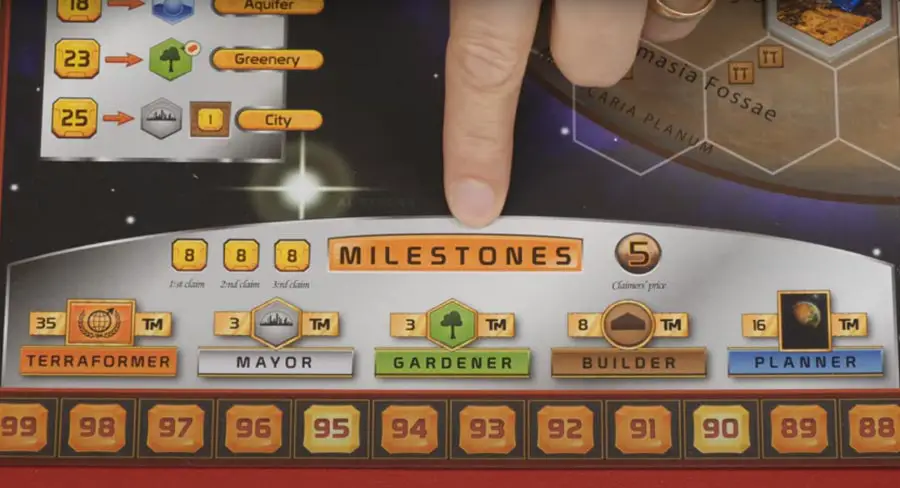
Fund an Award
When you take an action to claim an Award, you pay the corresponding cost which increases after each player makes an action to claim one award. There are 5 awards up for grabs, and at the end of the game, winners receive 5 points and runner-ups receive 2 points.
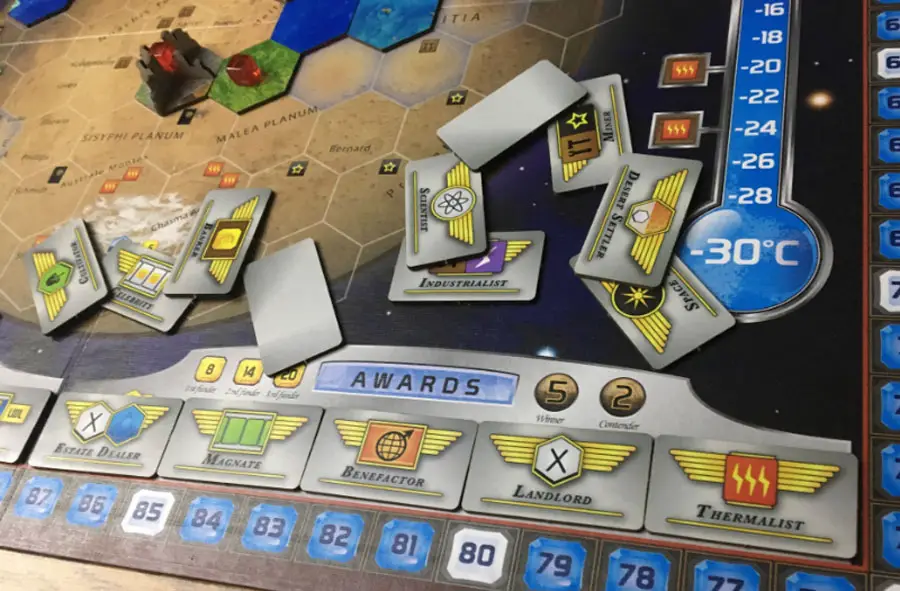
If two players tie in second place, both of them receive 2 points. If two players tie in first place, both players receive 5 points, with no other players in second place.
The 5 categories for Awards are:
- Landlord: Most tiles owned on the board.
- Banker: Highest Megacredit production value.
- Scientist: Most science tags in play, excluding Event Cards.
- Thermalist: Most Heat cubes at the end of the game.
- Miner: Most Steel and Titanium cubes at the end of the game.
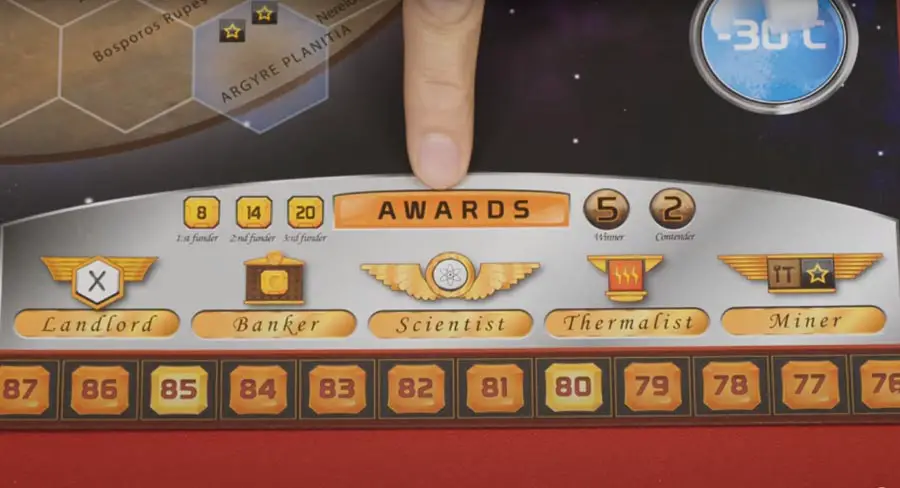
Corporation Abilities
Now, we’ve gone through all of the actions, but it’s important to keep in mind that unique corporations may also provide you with actions and abilities that you can use in your turn. So, keep an eye out for those and use them when it’s most appropriate.
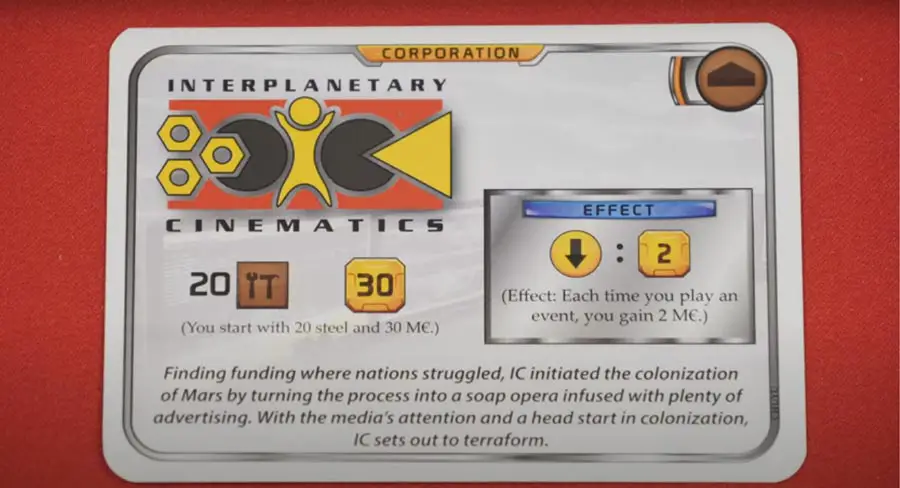
Production Phase
Once everyone has completed an action, you can move on to the production phase.
This phase begins by moving any Energy cube resources you own directly into the Heat resources area on your player board. After this step, you gain resources based on your current production levels.
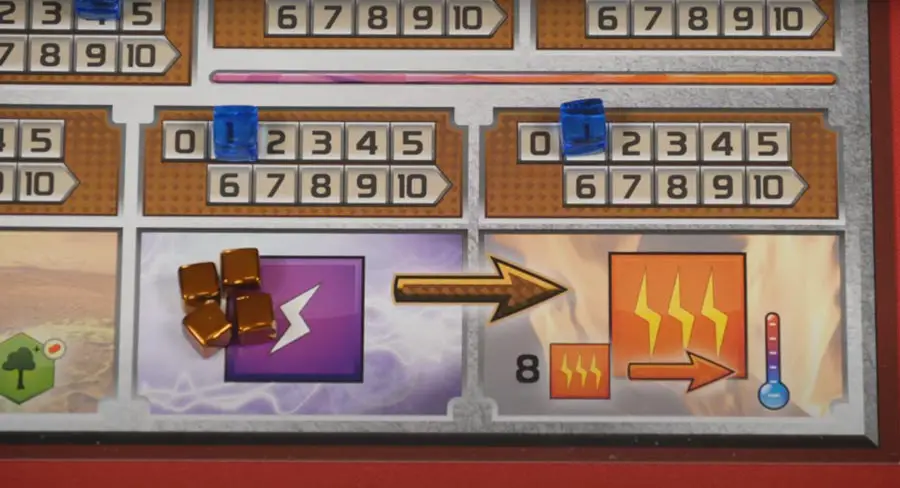
First, you get Megacredit resources equal to your TR plus the amount on your Megacredit production track. For instance, if you have a TR of 22 and a production value of 2 on your Megacredit track, you get a total of 24 Megacredits.
The rest of the resources you gain are based on their individual production value.
In this example, you’ll get 8 Steel, 8 Titanium, 7 Plants, 3 Energy, and 4 Heat.
Lastly, remove all your player markers from your used cards to show that they can be used again.
Now, you’re ready to start a new generation!
Player Order Phase
Unlike the first generation, the next generations will with a “Player Oder Phase” where the first-player token is passed clockwise and the generation marker is advanced one space on the board. This doesn’t necessarily affect the standard game, but it will have a significant function in the Variant and Solo versions of Terraforming Mars.
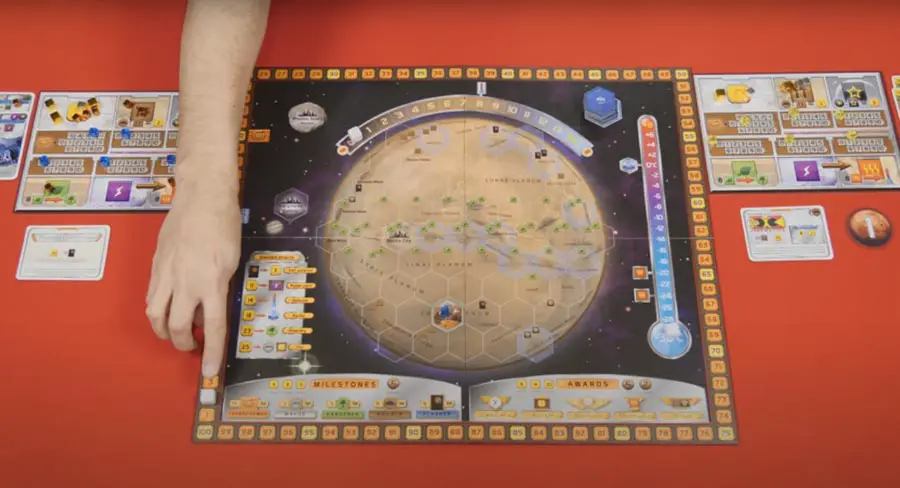
Research Phase
During the research phase, each player draws four cards and then chooses which to keep by paying 3 Megacredits back to the Supply. The cards you don’t choose, you place facedown on the discard pile, similar to what we did during Setup.
There’s no hand limit in the game and if you ever run out of cards from the draw pile, just reshuffle the ones from your discard pile and distribute accordingly.
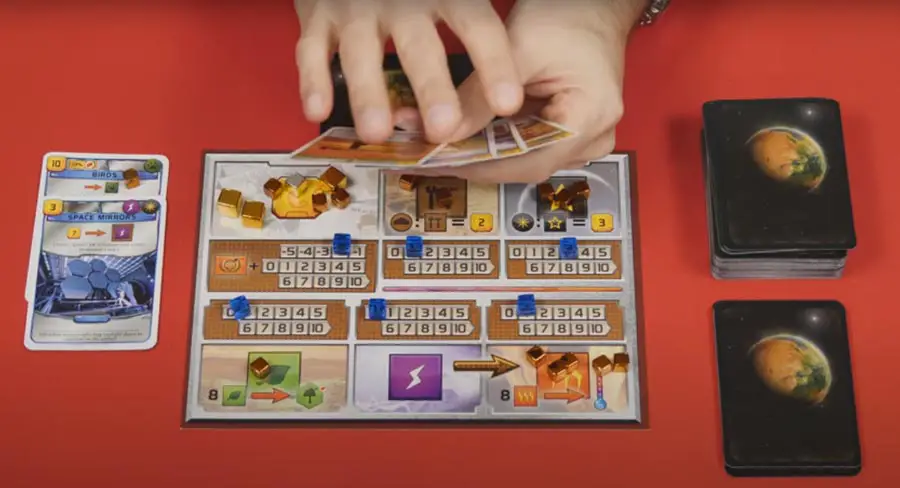
Now, it’s time again for the Action Phase, which will continue as previously explained in the first part of this guide.
The game continues until all three parameters have reached their maximum levels. After which, you’ll complete that round by finishing the Production Phase.
We mentioned before that players are given a final opportunity to make the planet a little greener, so after completing the Production Phase, players can convert any 8 plants into one new Greenery Tile to add to the board.
Final Scoring
Consider your Terraforming Rating (TR) as your basic score. You’ll add to this your Awards (5 points for 1st place and 2 points for 2nd place) and your Milestones (5 points for 1st place and 2 points for 2nd place).
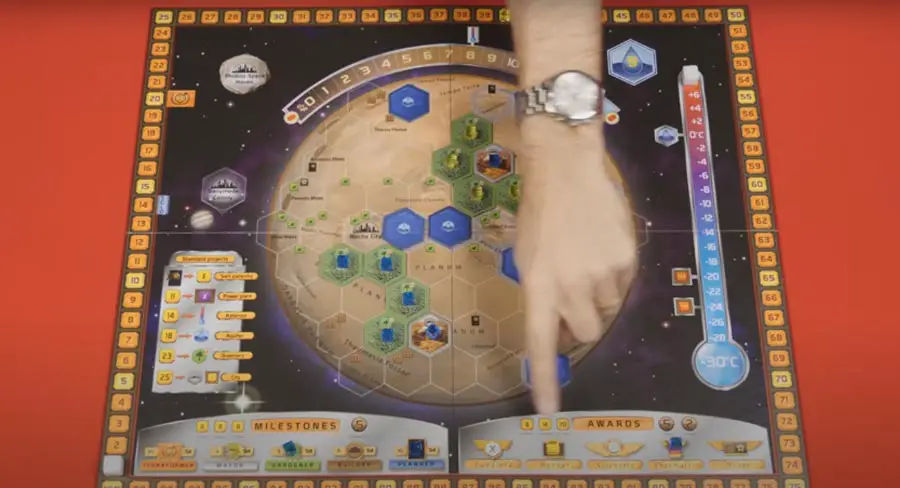
Again, if 2 players tie for 2nd place, each player gets 2 points each. But if 2 players tie at 1st place, both players get 5 points and no other players will be nominated for 2nd place.
You get 1 point for every Greenery Tile you have in place. Of each City Tile you own, scores are appointed for every Greenery Tile you have adjacent to it (1 each).
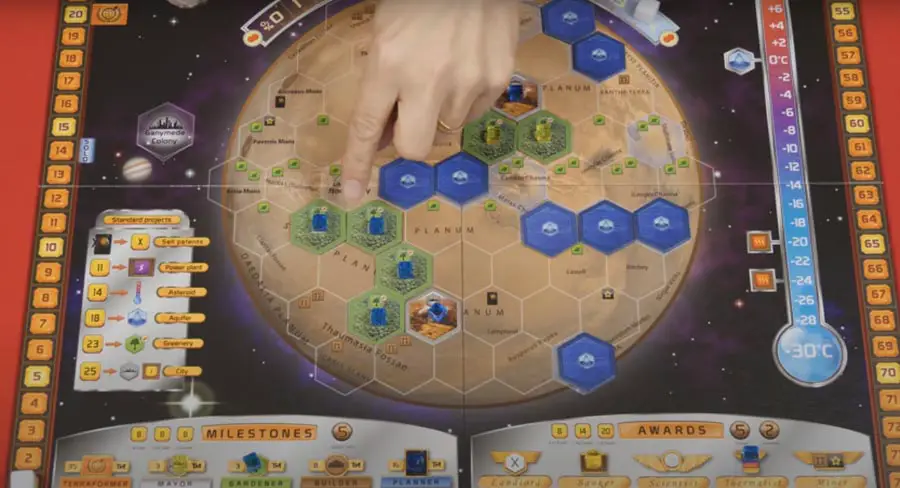
Finally, count all your Victory points from your face-up cards and flip over any facedown cards to gain the points from those as well.
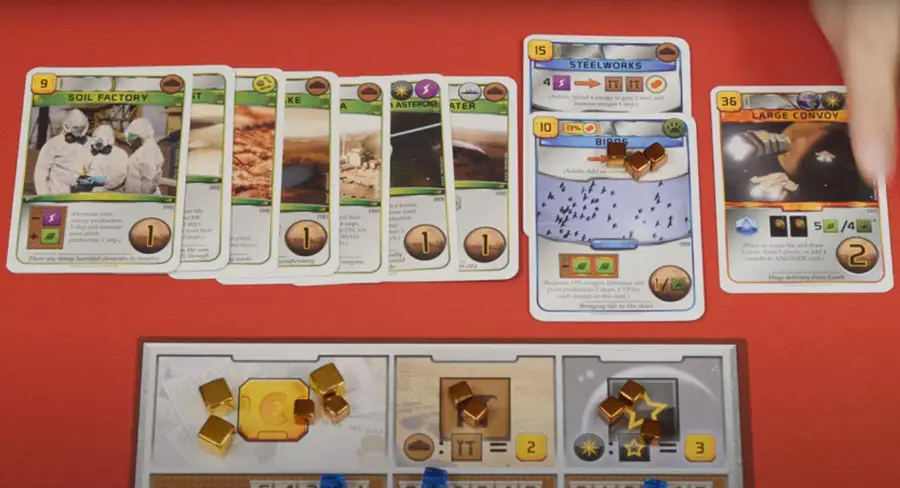
At this stage, the player with the most points is the victor. But in the case of a tie, the player with the most Megacredits wins.
Terraforming Mars Variants
Terraforming Mars has two variants that we’ll be briefly going over in this section. The Solo Variant and the Corporate Era.
Solo Variant
When playing the Solo Variant of Terraforming Mars, your goal is to terraform Mars before 14 generations have passed.
To start playing, add the Corporate Era cards to your deck. Draw 2 Corporation Cards and 10 Project Cards and keep the ones you want to play with. Just like the standard game, each project card you choose to keep in your hand will cost 3 Megacredits. Now, place one player marker on TR “14” which will be marked “Solo” on your game board. Then place one of the generation markers on TR “1.”
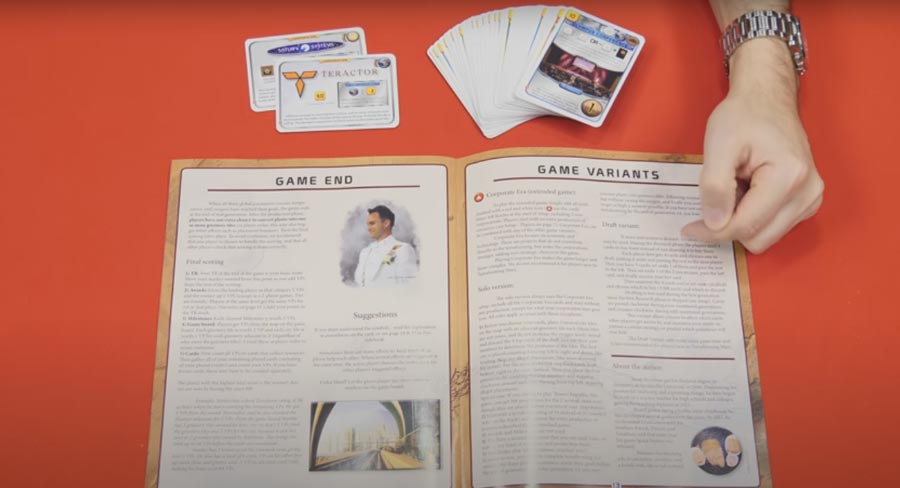
Next, you’ll add 2 neutral City Tiles and Greenery Tiles to your game board. To do this, draw a card from your deck and use the number on the upper left side of the card as a basis for where to place your tile. For your ease and reference, watch this video.
Once all of this is set, you can start playing as you would in the standard game, until you max out all 3 Global Parameters.
Corporate Era Variant
The Corporate Era Variant is an extended version of Terraforming Mars, meaning it takes longer to complete. This adds in all the corporate cards that you’d normally discard during a base game, and it also means that you start the game with ZERO production values for ALL of your resources. This is a more complicated variant of the game, which is why we don’t recommend it for beginners.
When you choose your four corporate cards, take one and pass the remaining three to the next player on your left. Keep doing this until all players have four cards in their hands and discard the ones that you don’t want to use as standard. This adds more player interaction in the game, as it can help you hinder your opponents from getting their hands on great cards. The only downside is it will slow things down a bit, too.
Conclusie
Terraforming Mars is a great game to play with your friends and family. It encourages strategic planning and challenges the player in a lot of ways, including budgeting and resource management. It’s great for any science-loving, Mars fanatic who wants to get a firsthand experience at terraforming the planet Mars.
We hope this guide on how to play Terraforming Mars has helped you understand the game a little better.
Have a great time exploring!